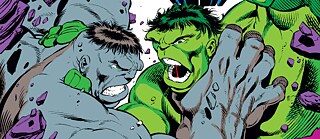Digital magazine “Fehler”
The same in green

The digital magazine “Fehler” celebrates mistakes, errors, and happy accidents and their innovative power with perspectives from Germany, India, Canada, and the USA. Hulk, the famous monster of Marvel comics, also owes its trademark to a printing error.
By Stefan Kloo
“Is he man or monster, or is he both?” was the question posed on the cover of the 1962 Marvel Comic “The Incredible Hulk #1”; a perfect description of the schizophrenic psyche of this future Marvel character. For fans of superhero comics, the Incredible Hulk has been an iconic figure for almost 60 years and even the uninitiated will be familiar with this angry green monster following the phenomenal success of the “Avengers” movies by Marvel. Green? If it hadn’t been for a printing error, the Incredible Hulk would have only been gray (and perhaps not nearly so popular).
Stan Lee, the man who created the Incredible Hulk, originally envisioned a gray-skinned hulk. Inspired by the Boris Karloff incarnation of Frankenstein’s tormented monster, Robert Louis Stevenson’s “Dr. Jekyll and Mr. Hyde”, and the golem from Jewish mythology, the character was intended to replicate the success of the orange-hued fan favorite The Thing from the Fantastic Four. As with The Thing, his skin color and grotesque stature were to be his unique defining features, as the Hulk would also have to do without any spandex outfit or cape. Stan Lee picked gray for the Hulk because he didn’t want to invoke any associations with a particular ethnic group and because he wanted a color that would appear “scary and chilling.”
In the first edition of the Hulk comic, however, the color that Lee had wanted turned out to be a mixture of various gray and even slightly greenish shades. On some pages, the Hulk appeared radiant with a bright and almost metallic complexion, while on others his skin was a much darker charcoal-gray. The colors used in the actual comic simply did not correspond to the original copies supplied by the colorist Stan Goldberg.
The misprint can be explained: if in CMYK printing the color gray is desired but green is produced instead, it’s most likely because the press density is either too light on magenta or too heavy on a combination of cyan and yellow. When Lee saw the first published edition in which the Hulk’s skin at times had a greenish shimmer, he asked his colorist Stan Goldberg to make the Hulk green for the second edition. And that is how things remained: in most reprints, the first-edition Hulk was touched up to make him green, and the “Jolly Green Giant” was to become one of the most popular and complex stars in the Marvel Universe. Since the Hulk’s green skin has become so fundamental to the character, the misprint turned out to be serendipitous: it is estimated that this green antihero has generated more than a billion dollars in character licensing fees since his gray debut.
The digital magazine “Fehler” gathers more misunderstandings, faulty processors, or dead flies that unexpectedly lead to something new.